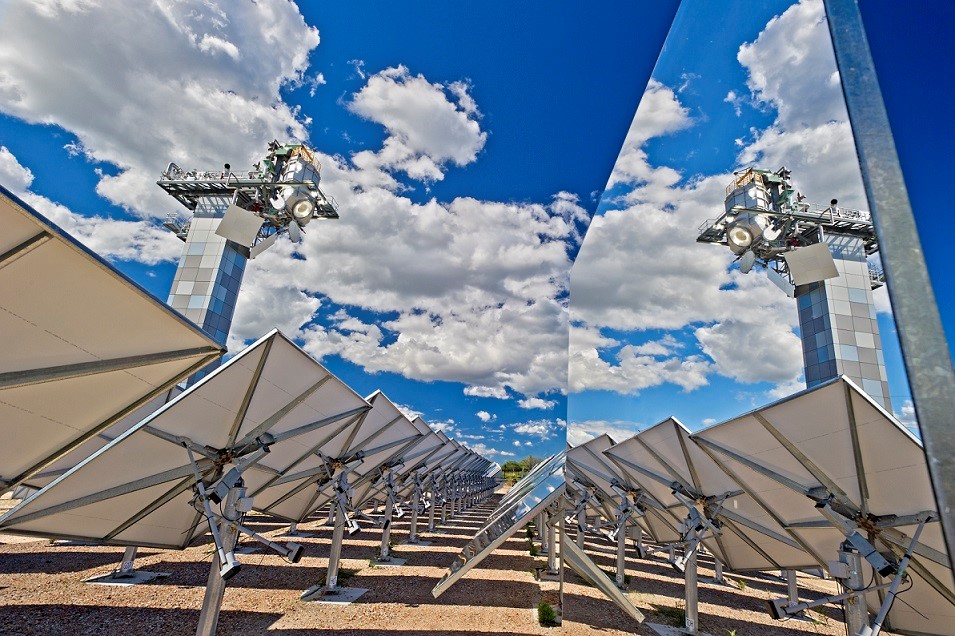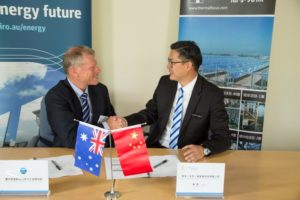They may look like bathroom mirrors and provide a great background for a selfie, but our solar thermal heliostat mirrors are hitting the world stage to help China meet its renewable energy targets.

picture of solar thermal technology
Sunny side-up: our solar thermal tech is making waves in China
They may look like bathroom mirrors and provide a great background for a selfie, but our solar thermal heliostat mirrors are hitting the world stage to help China meet its renewable energy targets.
We have announced a new partnership with Chinese company, Thermal Focus, to use our unique heliostat technology for concentrating solar thermal (CST) electricity generation in China. China aims to produce 1.4 GW of CST electricity generation by 2018, and 5 GW by 2020. This would double the world’s CST plants – that’s a whole lotta awesome looking mirrors making significant impacts to clean energy generation!
The heated facts about CST
Many people know about solar PV but when hearing about solar thermal, there’s often a few blank looks and scratching of heads. Here’s some important facts you should know if you want to wow your friends with large-scale solar power knowledge:
- Solar thermal technology uses a field of computer-controlled mirrors (heliostats) that accurately reflect and concentrate sunlight onto a receiver the size of a window on top of a tower.
- The concentrated sunlight may then be used to heat and store hot molten salt, which can generate superheated steam to drive a turbine for electricity generation.
- An advantage of this system is the very low cost of storing thermal energy, giving CST technology great potential for medium to large-scale solar power, even when the sun isn’t shining. So this means the power can be used through the day, and the night!
- A heliostat field can represent up to 40 per cent of the total plant cost so low cost, high precision heliostats are a crucial. Our unique design features smaller than conventional heliostats, and uses an advanced control system to get high performance from a cost-effective design.
This means that our partners can get more bang for their buck as our heliostat field design and software maximises how much heat the heliostat can capture, resulting in higher energy outputs.
Aussie tech, global impacts
Thermal Focus will be using our specialist heliostat hardware and software to commercialise our technology in China with a shared revenue stream back to Australia to fund what we do best, research!
CSIRO Chief Executive Dr Larry Marshall said he was proud of CSIRO Energy’s solar thermal technology team and their innovative science.
“Australia is a leader in clean energy technology and CSIRO’s partnership with China’s Thermal Focus takes our climate mitigation focus to a global stage,” Dr Marshall said.
“Through this collaboration and our continued solar research, we will be helping to generate cleaner energy, cost savings and technology export benefits for Australia; all lowering global greenhouse gas emissions.”
Our tech is not only shining the light on CST in China – we also have successful partnerships for heliostat commercialisation with Japan’s Mitsubishi Hitachi Power Systems, the Cyprus Institute, and Heliostat SA in Australia.
The announcement
It seemed apt to announce this milestone at the Asia-Pacific Solar Research Conference at the Australian National University in Canberra this week. Thermal Focus joined our solar thermal team to celebrate this successful outcome and to wet the ink on the licensing agreement.

Wes Stein, Chief Research Scientist, signs the deal with CEO of Thermal-Focus, Wei Zhu
We were also joined by the CEO of the Australian Renewable Energy Agency (ARENA), Ivor Frischknecht who described how ARENA’s investment in solar thermal research development over a number of years has enabled our technology to reach the point where it’s now being commercialised in international markets.
Mr Wei Zhu from Thermal Focus, is as excited as we are about the potential of solar thermal in China.
“CSIRO’s solar thermal expertise combined with China’s manufacturing capability will help expedite and deliver solar thermal as an important source of renewable energy in China, and help commercialise this technology on a much larger scale.”
So here’s three cheers to our Aussie tech continuing to make a global impact. The future for CST is looking bright.
Find out more about our solar thermal research or check out the drone footage of our CST research fields from the air


14th December 2016 at 10:37 pm
Sorry Andrew but we are not sending solar radiation to China. Solar radiation comes from the sun; we humans do not make it. But on a more serious note are you looking at the next generation of solar panels – the perovskite structure panel that will have a much higher efficiency that silicon solar? Do you realize that your panels will be redundant in 5 years?
14th December 2016 at 2:27 pm
Are Thermal Focus’s projects in China going to incorporate storage?
14th December 2016 at 2:24 pm
Show me the money.
Also, regarding the last paragraph in the answer to the first question above: Heliostats in the sky???
6th December 2016 at 2:37 am
I seem to recall that a similar facility in the US is killing significant nummbersof birds that accidently fly into the concentrated beam. Has CSIRO come up with a work around for this issue?
6th December 2016 at 12:03 pm
Hi Tom, thank you for your interest in our research.
With regard to your specific question, avian mortality is an issue for all development projects in terms of habitat degradation, habitat loss, habitat fragmentation, and direct fatality. It is important that we understand the ongoing anthropogenic (human caused) environmental impact of any development.
Solar projects including solar photovoltaic farms and concentrating solar thermal (CST) projects are increasingly monitoring avian impacts and attempting to mitigate these where possible.
This study (http://www.evs.anl.gov/downloads/ANL-EVS_15-2.pdf) by the US Department of Energy reports on avian fatality estimates from all causes from various studies. There is also this study conducted in July 2016 (http://www.sciencedirect.com/science/article/pii/S0960148116301422).
Recently in the US, there has been a further drop in incidents at operating CST plants with new distributed standby locations for the heliostats when they are not use, rather than concentrated areas in the sky which were used in the commissioning phase.
3rd December 2016 at 4:28 pm
This is excellent work, so why isn’t the Federal Government looking at this?
We have the highest levels of solar radiation in the world and we are sending it to China.
This Government’s lack of vision never ceases to amaze me.